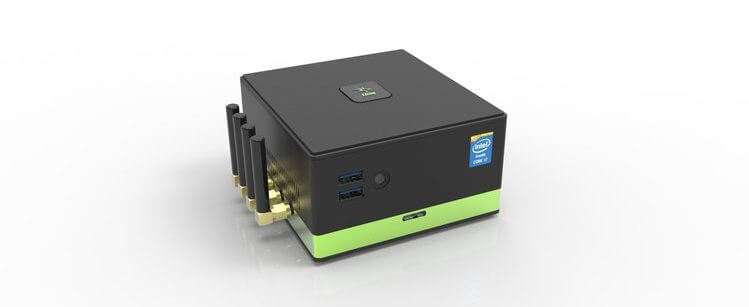LimeNET SDR Based Wireless Networks Crowdfunding Campaign
Following the success of the LimeSDR, the Lime team have started work on their next SDR project called ‘LimeNET’ which will eventually be released for crowdfunding on CrowdSupply. To be notified when the campaign is released you can sign up here.
The LimeNET SDR is essentially a high-end computer combined together with a LimeSDR board, and all placed in a small box. The goal is to create self contained base stations for cellular and IoT applications. LimeNET devices come in two flavors, the LimeNET Mini and the standard LimeNET.
LimeNET Mini
A software defined radio (SDR) small cell network in a box for mobile and IoT applications, based on an Intel i7 processor and the open source LimeSDR board. This combination makes it an ideal implementation for high data rate communication applications such as to 2-5G radio access to IoT nodes and much more.
- Processor: Intel Core i7-7500U CPU 2-core 2.7/3.5 GHz
- Memory: 32 GB DDR4 2133 MHz
- Storage: 512 GB SSD
- Connectivity: 1 x USB 3.1 type C, 1 x USB 3.1, 2x USB 3.0, 1 x Gigabit Ethernet
- Radio: LimeSDR USB Type-A
LimeNET
A software defined radio (SDR) high capacity network in a box for mobile and IoT applications, based on an Intel i7 processor and the open source LimeSDR PCIe card. It covers the same applications as the mini version for wide area networks.
- Processor: Intel Core i7-6950X CPU 10-core 2011-3 140 W 3.0 GHz 25 MB Cache
- Memory: 64 GB DDR4 2133 MHz
- Storage: 1 TB SSD
- Connectivity: 2 x USB 3.1, 4 x USB 3.0, 1 x Gigabit Ethernet
- Radio: LimeSDR PCIe

The LimeNET press release reads:
Confronted with flat revenues, spiralling infrastructure costs and massively escalating data demands, the telco industry is facing a crisis point. It needs exponentially more cost-effective solutions, as well as new revenue streams, and needs to find them quickly. Operators face a simple choice; either revise their business models, or lose market share to new incumbents.
Lime Micro and Canonical are looking to turn the mobile telephony business model on its head. Telco hardware is expensive, slow to develop, and has proven a ‘break’ to innovation in the industry. By ‘open sourcing’ Lime Microsystems’ 5G and IoT capable SDR base station design, Lime and Canonical are looking to effectively ‘commoditise’ network hardware and shift the value centre towards software.
LimeSDR-based base stations can not only run cellular standards from 2G or 5G, as well as IoT protocols like LoRa, Sigfox, NB-IoT, LTE-M, Weightless and others but any type of wireless protocol. Open source base stations allow R&D departments to try out new ideas around industrial IoT, content broadcasting and many more. Commoditised base stations allow any enterprise to run their own base station and get spectrum from their operators as a service. Base stations can have new form factors as well, like being embedded into vending machines or attached to drones.
“It’s clear that existing telco business models are quickly running out of steam,” commented Maarten Ectors, VP IoT, Next-Gen Networks & Edge Cloud, Canonical, “and that operators need to find new revenue streams. Together with Lime Microsystems, we’re looking to initiate a ‘herding’ behaviour that will usher in the age of the largely software-enabled telco network. Through its open sourced SDR design Lime will encourage a wide range of manufacturers to produce more cost-effective base stations. And, following enormous interest in our first crowdfunding initiative, we already have the critical mass of developers required to deliver the significant software innovation the industry requires.”
“This kind of model is, without a doubt, where the industry needs to go,” commented Ebrahim Bushehri, CEO, Lime Microsystems. “There are several reasons why Canonical’s heavy commitment in this project over the past couple of years has been so important. For one, Canonical shares our vision of an entirely software-enabled future for telco and IoT networks. Secondly, Canonical’s efficient, hyper-secure IoT OS Ubuntu Core is the perfect platform to enable this vision. Thirdly, this collaboration has helped us to gather the critical mass of developers required to kick-start the programme.”
Over 3,600 developers are currently involved in efforts to create apps, called Snaps, for LimeSDR, with several free and paid-for apps having already appeared on the open community LimeSDR App Store, as well as Lime’s invite-only app store, LimeNET.
Intel? why not Ryzen??